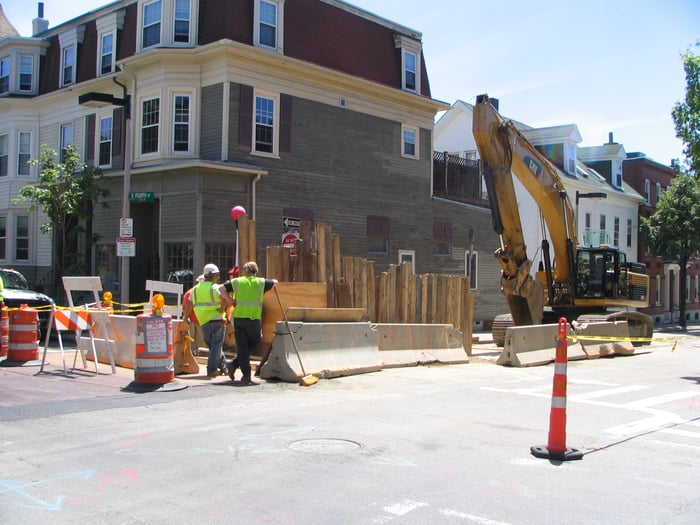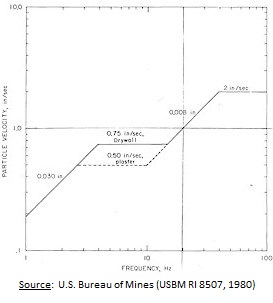From a contractor’s arsenal, the use of heavy construction equipment and blasting are common and efficient means of tackling various work. At some point in time it is highly likely that these types of construction activities will be employed within an area close to you.
 Whether it is blasting related to mass excavation in the neighborhood, hydraulic rock breaking involved with the foundation work down the street, or the use of heavy equipment for the construction next door, the associated noise and vibration can be a nuisance at best, and often can be unsettling and possibly damaging to the area properties.
Whether it is blasting related to mass excavation in the neighborhood, hydraulic rock breaking involved with the foundation work down the street, or the use of heavy equipment for the construction next door, the associated noise and vibration can be a nuisance at best, and often can be unsettling and possibly damaging to the area properties.
Pre-construction Condition Surveys
If you know that there will be a large construction project near your property - or if you are the construction company that will be heading up the project - it is diligent to hire a firm to conduct a pre-construction condition survey. A pre-construction survey is a thorough process that documents the condition of the property, or properties that may be impacted by the construction activity. Pre-construction condition surveys involve visual observation, photographic/video recording devices, and other diagnostics to report on the existing condition of the property prior to the start of construction.
The pre-construction condition survey not only serves the property owner in the case of identifying and confirming damage caused by vibration but also protects the construction company in avoiding unnecessary claims that could be propagated after the construction process.
How much vibration is too much?
While vibration can certainly be a nuisance, it is important to note that the human response to vibration can be extremely sensitive. Although sensitivity may vary widely, in general humans are able to feel vibration at a much lower intensity than that which might result in property damage. When people feel vibrations they often will inspect their properties and discover cracks or damage that were there before the vibration. Since they had not completed a close inspection of the property previously, they often think the cracks were caused by the vibrations.
Cracking within some finishes such as gypsum board installations and cast-in-place concrete material is not uncommon and can stem from shrinkage/swelling or temperature variations. Meanwhile, older buildings with plaster finishes and older construction materials may be more susceptible to vibration damage.
While the U.S. Bureau of Mines developed standards and thresholds for safe blasting and vibration levels, in some cases a determination of the vibration intensity must be estimated in consideration of equipment specifics, soil characteristics, and historical information. In each instance, the severity is analyzed with respect to distance and site specifics in order to determine whether the vibrations from a particular event were intense enough to cause damage to property.
Assessing possible damage
If you believe that your insured property may have sustained damage due to vibration-related sources, or if you are facing a claim that your project caused damages, CCA can assess the damages to determine whether or not a claim is justified in a few ways:
- Reviewing pre-construction condition surveys: This information typically includes photos with notation, video recording with corresponding narrative, or a combination of the two and is typically available via the general contractor or blasting company.
 Analyzing seismograph reports: The use of seismographs to monitor vibrations is typically required of area blasting work and is occasionally utilized on large-scale excavation activities or pile driving operations. If seismographs were utilized, an investigation of possible damages begins with the compilation of the data contained on the seismograph records. These records are typically held at the local area fire department’s public safety office. CCA’s review and analysis of the seismograph information can determine whether the vibration intensities reached levels that may result in damage.
Analyzing seismograph reports: The use of seismographs to monitor vibrations is typically required of area blasting work and is occasionally utilized on large-scale excavation activities or pile driving operations. If seismographs were utilized, an investigation of possible damages begins with the compilation of the data contained on the seismograph records. These records are typically held at the local area fire department’s public safety office. CCA’s review and analysis of the seismograph information can determine whether the vibration intensities reached levels that may result in damage. - Determining vibration intensities: The use of heavy construction equipment does not always involve the use of seismograph recording devices. As such, the anticipated vibration characteristics must be estimated. CCA’s determination is based on the manufacturer’s equipment data as well as historical references. This estimate is further refined with respect to the distance between the subject property and the source, as well as the soil characteristics and other site considerations.
- Inspection of the property: In addition to gathering site-specific information, documentation and assessment of the reported damage typically occur during CCA’s property inspection. Occasionally, conditions in the field will assist in the determination of the claim, such as the observance of evidence indicating a pre-existing condition. For example, an accumulation of dust, or paint applied along the inside surfaces of a crack may reveal that the condition was present for an extended period of time.
- Other factors: While every situation is unique, there are a number of other areas that CCA can review. These include, but are not limited to, construction material, age of the building, composition of the soil between the source of the vibration and the property, and others.
- Additional work – assessing causation: While the potential vibration resulting from area blasting is a concern, other possible adverse effects can also cause damage. Airblast and flyrock stemming from blasting activity should also be considered. It is also possible that the reported damage is completely unrelated. CCA can provide additional analysis on the likely cause and origin of the damage.
CCA is ready to assist insurers, contractors, developers, and property owners in the investigation and analysis of vibration-related claims. If you have concerns about possible property damage due to vibration-related sources, contact CCA. We have experience investigating these claims, whether it involves a single-family home or a large-scale construction project, and can help you to distinguish if the damage is related to vibration-related sources or was caused some other way.

 Analyzing seismograph reports: The use of seismographs to monitor vibrations is typically required of area blasting work and is occasionally utilized on large-scale excavation activities or pile driving operations. If seismographs were utilized, an investigation of possible damages begins with the compilation of the data contained on the seismograph records.
Analyzing seismograph reports: The use of seismographs to monitor vibrations is typically required of area blasting work and is occasionally utilized on large-scale excavation activities or pile driving operations. If seismographs were utilized, an investigation of possible damages begins with the compilation of the data contained on the seismograph records.

